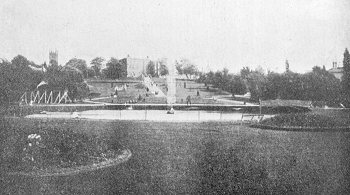Molineux House and Grounds Writing of Wolverhampton some thirty years ago, a contributor to a London publication says: " The ground is black, the atmosphere is black, the water is black, the people are black. So black is everything, in fact, that the visitor will find it difficult to spend an hour or two in it without having black hands and a black face . . . . . Fires to the right of us, fires to the left, fires behind us, fires before, red and fierce, lurid and grim, mocking the gloom, and making night hideous. The whole scene suggests the idea of a grand centre of volcanic action, and calls to mind the Pandemonium of Milton, and the watch fires of the fallen angels when they warred against Michael and his host." Certainly a graphic descriptive; but the writer must have been the possessor of a more than ordinary imaginative mind. There can be no objection to Wolverhampton being styled the metropolis of the Black Country, but the statement that the inhabitants live in perpetual Cimmerian gloom will be strongly resented. Our illustration shows Molineux House and Grounds about thirty years ago, and it certainly has not the appearance of a place where visitors would be inflicted with black hands and faces.
During their residence the grounds were nicely laid out, amongst other attractions being an aviary and a small menagerie of wild animals. The Molineux family always "kept up" St. Clement's Day, the 23rd of November, and as St. Clement is said to have suffered martyrdom by being thrown into the sea with an anchor fixed about his neck; and as moreover an anchor has been assigned to him as an emblem, it is only just and proper that his memory should be kept green in the metropolis of the Black Country, more especially as he is held to be the patron saint of the blacksmiths. It was customary on this day for the lads in the neighbourhood of Molineux House to make a call at this residence, and they were received in the main entrance hall by Mr. and Mrs. Molineux, who sat in state at the far end. All the youngsters wore pinafores, some, it must be admitted, larger than others and they were sent away gladdened by being made the happy possessors of a plentiful supply of seasonable fruit and nuts. It was formerly customary for boys, and the lower class of people generally, to go about on this day begging for liquor, wherewith they made a regale at night. Hence, in a certain class of old almanacs, the day was signified by the figure of a pot. At Molineux House, however, the pot was conspicuous by its absence on St. Clement's Day. After remaining vacant for a few years, the house and grounds were taken by Mr. Brewster, of the Prince of Wales Concert Hall, who made it a pleasure resort, with many fetes and galas, and old members of the Foresters’ Friendly Society still remember the social gatherings which were held at Molineux Grounds under the superintendence of the late Alderman H. Willcock. As a specimen of what caught the public ear same thirty-five years ago, it may be mentioned that the song, "The Ratcatcher's Daughter," which held popular sway for many months in the country, was first sung at Molineux Grounds by the author, Sam Cowel. The chorus of this "classical" ditty was as follows:-
The South Staffordshire Industrial Fine Arts Exhibition was inaugurated here by Earl Granville, upon the 11th of May, 1869; it remained open for five months, and resulted in a complete financial success. Temporary buildings were erected upon the plateau adjoining the house, and here were shown the process and results of the many manufactures of the town and district. A most interesting collection of pictures, lent by gentlemen of the neighbourhood, would alone have sufficed to make this Exhibition memorable. A few years later the grounds became famous for bicycle races, under the management of Mr. Macgregor. The first champion races were rode on what was then termed the "top green," now better recognised as the old skating rink. It was here, some thirty years ago, that such champions as Johnson, Palmer, Forder, and Jack Kean struggled for supremacy on the old "bone-shaker." A few years later Kean and Cooper became the "stars" of the new track round the pool as shown in our illustration, and in 1880, Dick Howell, then only 17 years of age, astonished the cycling world by beating the champions and all previous records at Molineux Grounds. Professional cycling having had its day, the Grounds came again under a cloud, but in Sept., 1889, " me little Wanderers" tripped on to the Grounds, and since then all has gone as merry as marriage bells. |




